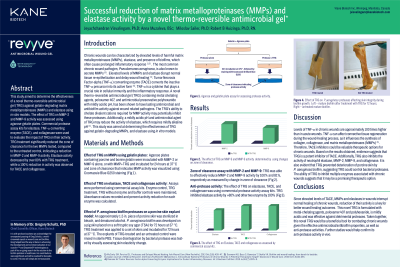Laboratory Research
(LR-047) Successful Reduction of Matrix Metalloproteinases (MMPs) and Elastase Activity by a Novel Thermo-reversible Antimicrobial Gel

Chronic wounds can be characterized by elevated levels of harmful matrix metalloproteinases (MMPs), elastase, and presence of biofilms, which often cause prolonged inflammatory response. MMPs and elastase can disrupt normal tissue re-epithelization and delay wound healing. A novel thermo-reversible antimicrobial gel (TRG) containing metal chelating agents, poloxamer 407, and antimicrobial preservative polyhexanide with mildly acidic pH, has been shown to have lasting antimicrobial and antibiofilm activity against wound related pathogens. The TRG’s ability to chelate divalent cations required for MMP activity may potentially inhibit these proteases. Additionally, a mildly acidic pH and antimicrobial agent of TRG may reduce the activity of elastase, which requires mildly alkaline pH. This study was aimed at determining the effectiveness of TRG against gelatin-degrading MMPs, and elastase using in vitro models.
Methods: Effect of the TRG on MMP-3 and MMP-9 activity was assessed using agarose-gelatin plates. MMP-3 or MMP-9 plus TRG or untreated enzyme controls were incubated for 24 hours at 37°C and zone of clearance was visualized using Coomassie Blue G250 staining. Microwells containing the neutrophil elastase and colorimetric substrate were treated with TRG, and the absorbance at 405 nm was measured after 5, 10, 20, and 30 minutes of incubation at 37°C. Percent reduction in elastase activity was determined by comparing absorbance for TRG treatment groups relative to untreated controls.
Results:
TRG treatment significantly reduced the zone of clearance for two MMPs tested, compared to an untreated control, indicating reduction of MMP-3 and MMP-9 activity. Elastase activity decreased by over 80% for TRG treatment after ≤30 minutes of incubation.
Discussion:
Since elevated levels of MMPs and elastases in wounds interrupt normal healing of chronic wounds, reduction of their activity is a key for better wound healing outcomes. This novel TRG is formulated with metal-chelating agents, poloxamer 407 and polyhexanide, is mildly acidic and was effective against detrimental proteases. Taken together, this novel TRG would be a beneficial tool for combating chronic wounds given the effective antimicrobial/antibiofilm properties, as well as anti-protease activities. Further studies would help confirm its anti-protease activity in vivo.

.jpg)